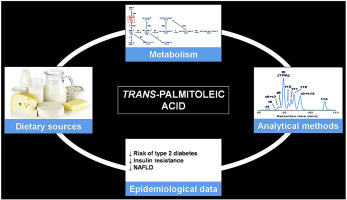Our official English website, www.x-mol.net, welcomes your feedback! (Note: you will need to create a separate account there.)
Trans-palmitoleic acid (trans-9-C16:1, or trans-C16:1 n-7): Nutritional impacts, metabolism, origin, compositional data, analytical methods and chemical synthesis. A review.
Biochimie ( IF 3.9 ) Pub Date : 2019-12-16 , DOI: 10.1016/j.biochi.2019.12.004 Etienne Guillocheau 1 , Philippe Legrand 2 , Vincent Rioux 2
Biochimie ( IF 3.9 ) Pub Date : 2019-12-16 , DOI: 10.1016/j.biochi.2019.12.004 Etienne Guillocheau 1 , Philippe Legrand 2 , Vincent Rioux 2
Affiliation

|
Since the early 2010s, dietary trans-palmitoleic acid (trans-9-hexadecenoic acid, trans-9-C16:1 in the Δ-nomenclature, trans-C16:1 n-7 in the Ω-nomenclature, TPA) has been epidemiologically associated with a lower risk of type 2 diabetes in humans. Thanks to these findings, TPA has become a nutrient of interest. However, there is a lot of unresolved crucial questions about this dietary fatty acid. Is TPA a natural trans fatty acid? What kind of foods ensures intakes in TPA? What about its metabolism? How does dietary TPA act to prevent type 2 diabetes? What are the biological mechanisms involved in this physiological effect? Clearly, it is high time to answer all these questions with the very first review specifically dedicated to this intriguing fatty acid. Aiming at getting an overview, we shall try to give an answer to all these questions, relying on appropriate and accurate scientific results. Briefly, this review underlines that TPA is indeed a natural trans fatty acid which is metabolically linked to other well-known natural trans fatty acids. Knowledge on physiological impacts of dietary TPA is limited so far to epidemiological data, awaiting for supplementation studies. In this multidisciplinary review, we also emphasize on methodological topics related to TPA, particularly when it comes to the quantification of TPA in foods and human plasma. As a conclusion, we highlight promising health benefits of dietary TPA; however, there is a strong lack in well-designed studies in both the nutritional and the analytical area.
中文翻译:

反式棕榈油酸(trans-9-C16:1或trans-C16:1 n-7):营养影响,代谢,来源,组成数据,分析方法和化学合成。回顾。
自2010年代初以来,饮食中的反式棕榈酸(反式9-十六碳烯酸,反式Δ-命名法中的反式9-C16:1,反式Ω-命名法中的反式C16:1 n-7,TPA)已成为流行病学与人类2型糖尿病的较低风险相关。由于这些发现,TPA已成为人们关注的营养。但是,关于这种饮食脂肪酸有很多悬而未决的关键问题。TPA是天然的反式脂肪酸吗?哪种食物可以确保TPA的摄入量?那它的新陈代谢呢?饮食中的TPA如何预防2型糖尿病?这种生理作用涉及哪些生物学机制?显然,现在正是时候专门针对这种有趣的脂肪酸进行首次评论,回答所有这些问题。为了获得概述,我们将尝试回答所有这些问题,依靠适当和准确的科学结果。简而言之,该评论强调TPA确实是天然反式脂肪酸,它与其他众所周知的天然反式脂肪酸代谢相连。到目前为止,有关饮食中TPA的生理影响的知识仅限于流行病学数据,有待补充研究。在此多学科综述中,我们还强调与TPA相关的方法论主题,尤其是在食品和人血浆中TPA的定量分析方面。结论是,我们强调了饮食中TPA的健康益处;但是,在营养和分析领域都缺乏精心设计的研究。该评价强调TPA确实是天然反式脂肪酸,它与其他众所周知的天然反式脂肪酸代谢相连。到目前为止,有关饮食中TPA的生理影响的知识仅限于流行病学数据,有待补充研究。在此多学科综述中,我们还强调与TPA相关的方法论主题,尤其是在食品和人血浆中TPA定量方面。结论是,我们强调了饮食中TPA的健康益处;但是,在营养和分析领域都缺乏精心设计的研究。该评价强调TPA确实是天然反式脂肪酸,它与其他众所周知的天然反式脂肪酸代谢相连。到目前为止,有关饮食中TPA的生理影响的知识仅限于流行病学数据,有待补充研究。在此多学科综述中,我们还强调与TPA相关的方法论主题,尤其是在食品和人血浆中TPA定量方面。结论是,我们强调了饮食中TPA的健康益处;但是,在营养和分析领域都缺乏精心设计的研究。我们还强调与TPA相关的方法论主题,尤其是在食品和人体血浆中TPA定量方面。结论是,我们强调了饮食中TPA的健康益处;但是,在营养和分析领域都缺乏精心设计的研究。我们还强调与TPA相关的方法论主题,尤其是在食品和人体血浆中TPA定量方面。结论是,我们强调了饮食中TPA的健康益处;但是,在营养和分析领域都缺乏精心设计的研究。
更新日期:2019-12-17
中文翻译:

反式棕榈油酸(trans-9-C16:1或trans-C16:1 n-7):营养影响,代谢,来源,组成数据,分析方法和化学合成。回顾。
自2010年代初以来,饮食中的反式棕榈酸(反式9-十六碳烯酸,反式Δ-命名法中的反式9-C16:1,反式Ω-命名法中的反式C16:1 n-7,TPA)已成为流行病学与人类2型糖尿病的较低风险相关。由于这些发现,TPA已成为人们关注的营养。但是,关于这种饮食脂肪酸有很多悬而未决的关键问题。TPA是天然的反式脂肪酸吗?哪种食物可以确保TPA的摄入量?那它的新陈代谢呢?饮食中的TPA如何预防2型糖尿病?这种生理作用涉及哪些生物学机制?显然,现在正是时候专门针对这种有趣的脂肪酸进行首次评论,回答所有这些问题。为了获得概述,我们将尝试回答所有这些问题,依靠适当和准确的科学结果。简而言之,该评论强调TPA确实是天然反式脂肪酸,它与其他众所周知的天然反式脂肪酸代谢相连。到目前为止,有关饮食中TPA的生理影响的知识仅限于流行病学数据,有待补充研究。在此多学科综述中,我们还强调与TPA相关的方法论主题,尤其是在食品和人血浆中TPA的定量分析方面。结论是,我们强调了饮食中TPA的健康益处;但是,在营养和分析领域都缺乏精心设计的研究。该评价强调TPA确实是天然反式脂肪酸,它与其他众所周知的天然反式脂肪酸代谢相连。到目前为止,有关饮食中TPA的生理影响的知识仅限于流行病学数据,有待补充研究。在此多学科综述中,我们还强调与TPA相关的方法论主题,尤其是在食品和人血浆中TPA定量方面。结论是,我们强调了饮食中TPA的健康益处;但是,在营养和分析领域都缺乏精心设计的研究。该评价强调TPA确实是天然反式脂肪酸,它与其他众所周知的天然反式脂肪酸代谢相连。到目前为止,有关饮食中TPA的生理影响的知识仅限于流行病学数据,有待补充研究。在此多学科综述中,我们还强调与TPA相关的方法论主题,尤其是在食品和人血浆中TPA定量方面。结论是,我们强调了饮食中TPA的健康益处;但是,在营养和分析领域都缺乏精心设计的研究。我们还强调与TPA相关的方法论主题,尤其是在食品和人体血浆中TPA定量方面。结论是,我们强调了饮食中TPA的健康益处;但是,在营养和分析领域都缺乏精心设计的研究。我们还强调与TPA相关的方法论主题,尤其是在食品和人体血浆中TPA定量方面。结论是,我们强调了饮食中TPA的健康益处;但是,在营养和分析领域都缺乏精心设计的研究。



























 京公网安备 11010802027423号
京公网安备 11010802027423号